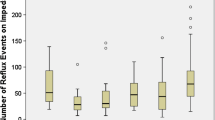Abstract
Background
Esophageal motility disorders are sometimes misdiagnosed on endoscopic examination. We aimed to identify the proportion of patients with esophageal motility disorders missed during endoscopy and their clinical characteristics.
Methods
Patients diagnosed with either disorder with esophagogastric junction outflow obstruction or major disorders of peristalsis using high-resolution manometry in our hospital from April 2015 to March 2021 were included in this study. Missed esophageal motility disorders were defined as patients with any endoscopic misdiagnosis such as normal esophagus or esophagitis within 1 year before the manometric diagnosis. We determined the proportion of missed esophageal motility disorders and identified independent predictors of missed esophageal motility disorders using multivariate analysis.
Results
A total of 41/273 esophageal motility disorders (15.0%; 95% confidence interval 11.3–19.7%) were missed during endoscopy within 1 year before manometric diagnosis. In the stepwise logistic regression analysis, the following variables were selected as independent variables for patients with missed esophageal motility disorders during endoscopy: non-dilated esophagus (odds ratio = 4.87, 95% confidence interval: 1.81–13.12, p = 0.002), the presence of epiphrenic diverticulum (odds ratio = 8.95, 95% confidence interval: 1.88–42.65, p = 0.006), the use of transnasal endoscopy (odds ratio = 4.71, 95% confidence interval: 1.59–13.92, p = 0.005), and the combined use of esophagram (odds ratio = 0.023, 95% confidence interval: 0.0025–0.20, p = 0.0008).
Conclusions
Based on retrospective analysis, 15% of esophageal motility disorders were missed during endoscopy. Understanding the clinical characteristics of missed esophageal motility disorders could help improve endoscopic diagnoses.

Similar content being viewed by others
References
Boeckxstaens GE, Zaninotto G, Richter JE. Achalasia. Lancet. 2014;383:83–93.
Eckardt VF, Aignherr C, Bernhard G. Predictors of outcome in patients with achalasia treated by pneumatic dilation. Gastroenterology. 1992;103:1732–8.
Vaezi MF, Pandolfino JE, Vela MF. ACG clinical guideline: diagnosis and management of achalasia. Am J Gastroenterol. 2013;108:1238–49.
Niebisch S, Hadzijusufovic E, Mehdorn M, et al. Achalasia—an unnecessary long way to diagnosis. Dis Esophagus. 2017;30:1–6.
Kahrilas PJ, Bredenoord AJ, Fox M, et al. The Chicago Classification of esophageal motility disorders, v3.0. Neurogastroenterol Motil. 2015;27:160–74.
Iwakiri K, Hoshihara Y, Kawami N, et al. The appearance of rosette-like esophageal folds (‘esophageal rosette’) in the lower esophagus after a deep inspiration is a characteristic endoscopic finding of primary achalasia. J Gastroenterol. 2010;45:422–5.
Minami H, Isomoto H, Miuma S, et al. New endoscopic indicator of esophageal achalasia: “pinstripe pattern.” PLoS ONE. 2015;10: e0101833.
Gomi K, Inoue H, Ikeda H, et al. New endoscopic classification of the cardiac orifice in esophageal achalasia: champagne glass sign. Dig Endosc. 2016;28:645–9.
Japan Esophageal Society. Descriptive rules for achalasia of the esophagus, June 2012: 4th edition. Esophagus. 2017;14:275–89.
Howard PJ, Maher L, Pryde A, et al. Five-year prospective study of the incidence, clinical features, and diagnosis of achalasia in Edinburgh. Gut. 1992;33:1011–5.
Wang CH, Lee YC, Wang CP, et al. Use of transnasal endoscopy for screening of esophageal squamous cell carcinoma in high-risk patients: yield rate, completion rate, and safety. Dig Endosc. 2014;26:24–31.
de Oliveira JM, Birgisson S, Doinoff C, et al. Timed barium swallow: a simple technique for evaluating esophageal emptying in patients with achalasia. AJR Am J Roentgenol. 1997;169:473–9.
Oude Nijhuis RAB, Zaninotto G, Roman S, et al. European guidelines on achalasia: United European Gastroenterology and European Society of Neurogastroenterology and Motility recommendations. U Eur Gastroenterol J. 2020;8:13–33.
Kinoshita M, Tanaka S, Kawara F, et al. Peroral endoscopic myotomy alone is effective for esophageal motility disorders and esophageal epiphrenic diverticulum: a retrospective single-center study. Surg Endosc. 2020;34:5447–54.
Tanuma T, Morita Y, Doyama H. Current status of transnasal endoscopy worldwide using ultrathin videoscope for upper gastrointestinal tract. Dig Endosc. 2016;28:25–31.
Author information
Authors and Affiliations
Contributions
All authors have contributed to the content of this manuscript. HA and ST conceived and designed the study. HA, ST, FK, TT, HS, SU, CU, TN, and NI performed the experiments. HA and ST analyzed the data and wrote the initial draft of the manuscript. All other authors have contributed to data interpretation and critically reviewed the manuscript. All authors approved the final version of the manuscript and agreed to be accountable for all aspects of the work in ensuring that questions related to the accuracy or integrity of any part of the work are appropriately investigated and resolved.
Corresponding author
Ethics declarations
Ethical statement
All procedures followed were in accordance with the ethical standards of the responsible committee on human experimentation (institutional and national) and with the Helsinki Declaration of 1964 and later versions. Informed consent or substitute for it was obtained from all patients for being included in the study.
Conflict of interest
The authors declare no conflicts of interest for this article.
Additional information
Publisher's Note
Springer Nature remains neutral with regard to jurisdictional claims in published maps and institutional affiliations.
Rights and permissions
About this article
Cite this article
Abe, H., Tanaka, S., Kawara, F. et al. Esophageal motility disorders missed during endoscopy. Esophagus 19, 486–492 (2022). https://doi.org/10.1007/s10388-021-00903-4
Received:
Accepted:
Published:
Issue Date:
DOI: https://doi.org/10.1007/s10388-021-00903-4




